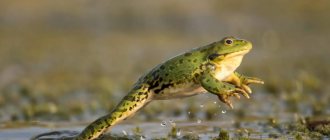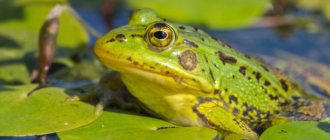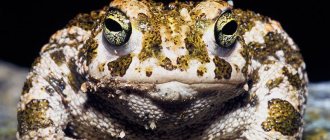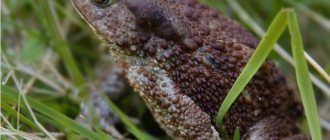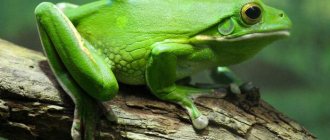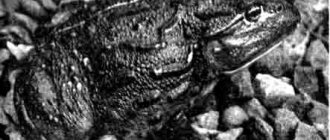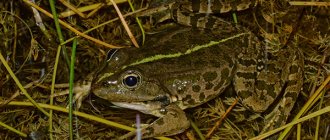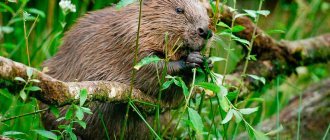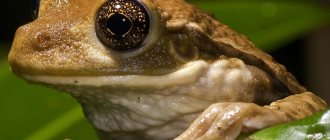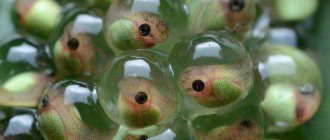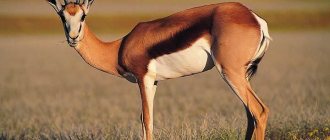- Wild animals
- >>
- Amphibians
Pipa is one of the most amazing frogs found mainly in South America, in the Amazon River basin. One of the unique features of this toad is that it can carry offspring on its back for 3 months. It is for this feature that zoologists call pipu “the best mother.”
Origin of the species and description
Photo: Pipa
The pipa's head is triangular in shape and exactly the same flattened as the entire body of this tropical frog. The eyes are located on top of the muzzle, they have no eyelids and are very small in size. One of the most interesting features of the gastrointestinal tract is the absence of teeth and tongue in these animals. Instead, the digestive organs are modified skin flaps located in the corners of the mouth. They look somewhat like tentacles.
Video: Pipa
Another significant difference from all other frogs is that the front legs of this amphibian do not have membranes at their ends and end in elongated fingers. And what’s even more surprising is that they have no claws, which distinguishes the Surinamese pipa in general from all higher animals. But on the hind limbs there are folds of skin, they differ in their thickness and are located between the toes. These folds make the frog's movement under water very confident.
The body length of the Suriname pipa almost never exceeds 20 cm. It is rare to encounter giant individuals whose length reaches 22-23 cm. The skin of this animal is very rough and wrinkled in structure, sometimes you can see black spots on the back. One of the most significant evolutionary “achievements” that allows the Suriname pipa to adapt to environmental conditions is its dim color (unlike the vast majority of tropical frogs). These frogs have gray-brown skin and a light belly.
Often there is a dark stripe that approaches the throat and covers the toad’s neck, thus forming a border on it. The sharp, unpleasant smell of an already unattractive animal (the “aroma” resembles hydrogen sulfide) also acts as a deterrent to potential predators.
Appearance and features
Photo: What pipa looks like
Pipa belongs to the class of amphibians, the pipa family. Species-specific unique features begin already at this stage - even in comparison with its relatives, pipa has a lot of differences, because of which many zoologists, when they first encountered this strange beast, even doubted whether it was a frog. So, the first significant difference from all other amphibians (and frogs in particular) is its special physique.
When you first notice a flat frog, the thought arises that it is very unlucky, because it looks as if it had been driven over by a roller skating rink, several times. Her body in its shape resembles a leaf fallen from some tropical tree, because it is thin and flattened. And without knowing all the subtleties, even admitting that what you see in front of you is not a fallen leaf, but a living creature from a warm-water tropical river, is very problematic.
These amphibians almost never leave the aquatic environment. Yes, during the dry season they can move to bodies of water that have not yet dried up, and except for dramatically changed weather conditions, nothing will ever scare these homebodies away. Pipa in general is a clear example of the impact of evolution on the animal’s body - due to the long life under water, the eyes of these amphibians became small and lost their eyelids, and atrophy of the tongue and tympanic septum occurred.
The Surinamese pipa, which lives in the Amazon River basin, was best described by writer Gerald Durrell in his work “Three Tickets to Adventure.” There are the following lines: “He opened his palms, and a rather strange and ugly animal appeared before my eyes. Yes, in appearance it looked like a brown toad that had come under pressure.
Her short, thin paws were positioned neatly at the corners of her square body, which looked reluctant to recall rigor mortis. The shape of her muzzle was sharp, her eyes were small, and her pipa was shaped like a pancake.
Where does pipa live?
Photo: Pipa frog
The preferred habitat of this frog is reservoirs with warm and turbid water, not characterized by strong currents. Moreover, the proximity to humans does not frighten her - Surinamese pipas settle near human settlements, they are often seen not far from plantations (mainly in irrigation canals). The animal simply loves the muddy bottom - by and large, the layer of mud is its place of residence.
Such amazing creatures inhabit the territory of Brazil, Peru, Bolivia and Suriname. There they are considered “the reigning amphibians of all fresh water bodies” - Surinamese pipas lead an exclusively aquatic lifestyle. These frogs can be easily seen not only in all kinds of ponds and rivers, but also in irrigation canals located on plantations.
Even a long period of drought is not able to force them to crawl out onto solid ground - peeps prefer to sit out in half-dried puddles. But along with the rainy season, real freedom begins for them - frogs fully indulge their souls, moving with the flow of rainwater through forests flooded by rainfall.
All the more surprising is the strong love of the Surinamese pipus for water, given the fact that these animals have well-developed lungs and rough, keratinized skin (these characteristics are more characteristic of terrestrial animals). Their body resembles a small flat 4-angled leaf with sharp corners on the sides. The junction of the head and the body is practically not expressed in any way. Eyes constantly look up.
Another habitat for Surinamese peeps is human aquariums. Despite their not particularly attractive appearance and the emanating smell of hydrogen sulfide, people who are interested in exotic animals are happy to breed these mysterious frogs at home. They unanimously claim that following the process of gestation of larvae by a female and the subsequent birth of tadpoles is very interesting and educational.
In the event that after reading the article you are imbued with sympathy for the Surinamese pipa and firmly decide to have such a frog at home, then immediately prepare a large aquarium. One amphibian should have at least 100 liters of water. For each subsequent individual - a similar volume. Why, it turns out that the Surinamese pipa only gets used to any conditions in the wild. In captivity, she experiences severe stress, and in order for this animal to give birth, it is necessary to provide a number of conditions.
These include:
- ensuring constant oxygen saturation of the aquarium;
- constant temperature. Fluctuations in values are permissible in the range from 28C to 24C;
- variety of diet. These frogs need to be fed not only with dried food for aquarium fauna, but also with earthworms, larvae of waterfowl insects and pieces of fresh fish.
In order for the Suriname pipa living in the aquarium to feel as comfortable as possible, sand with fine gravel and live algae should be poured onto the bottom.
A pet for exotic lovers
You can also get a Surinamese pipa at home if the appearance of these individuals does not cause persistent disgust in a person. Practical recommendations include the following.
- Toads love space. The minimum capacity of the aquarium is 100 liters.
- Water temperature is 20-25 degrees. Well-settled tap water is suitable.
- Any proximity is prohibited. The voracious pipa will eat aquarium fish and other defenseless individuals.
- For decoration, the bottom is covered with gravel and vegetation is placed.
- They feed pipa with large bloodworms, fry, earthworms, daphnia and even pieces of raw meat.
- Overfeeding pipa threatens with deformation of the vertebrae and the formation of an ugly hump on the back, which in no way will decorate this cutie.
The top surface must be tightly covered with a lid with small holes. This is done more for the safety and peace of mind of the residents, since at night the pipa is active and can leave its house. And an ugly toad walking in the dark is a likely cause of a heart attack for unprepared people.
What does pipa eat?
Photo: Pipa in the water
With its powerful and long fingers located on the front paws, the toad loosens the soil and looks for food, and then puts it in its mouth. She helps herself in such a noble process with growths on her paws. Taking into account the fact that they vaguely resemble stars, this frog is usually called “star-fingered”. The diet of the Suriname frog consists of various organic residues located at the very bottom of the reservoir, in the soil.
In addition, pipa eats:
- small fish and fry;
- worms;
- waterfowl insects.
Pipa frogs almost never hunt on the surface. Unlike ordinary frogs that we are used to seeing, they do not sit in the swamp and do not catch flying insects with their long tongue. Yes, they have rough skin and a large lung capacity, but the Suriname pipa feeds only when buried deep in the mud, or simply while in the water.
Regarding the rainy season, some researchers have noted how during the rainy season, South American amphibians appear on the shore and travel many hundreds of kilometers in order to find warm and dirty puddles located near the tropical forests. Already there they warm up and bask in the sun.
Now you know what to feed the pipa frog. Let's see how she lives in the wild.
What happens when poisoned by frogs and toads?
The venom of tailless amphibians acts mainly on the circulatory and nervous systems and the heart. Of course, in order to be poisoned, say, by the poison of a toad, you must take it into your mouth. Naturally, no normal person would do this, but poisoning with the venom of the terrible leaf climber is known. It is enough to pick up an amphibian with your bare hands, and if there are cuts, abrasions and cracks on the skin, this can lead to severe poisoning and even death. Just imagine the state of a person when, as a result of the action of poison on the neuromuscular system, breathing begins to weaken. The inhalation becomes shallow and superficial. Gradually, oxygen deficiency occurs, and the victim begins to suffocate. The heart and brain also suffer from a catastrophic lack of oxygen, convulsions occur, and then death from respiratory arrest.
The mechanism of action of leaf climber poison is as follows. At the border of nerve and muscle there is a small special plate that has the properties of both nervous tissue and muscle tissue, which is why it is called the neuromuscular synapse, or connective tissue. The intercostal muscles also have such plates, which, together with the diaphragm, carry out the movement of air when inhaling into the lungs and when exhaling outward, i.e. carry out the breathing process. It is on these plates that the action of the “cocoe” poison is directed. By turning them off from work, the poison thereby stops the transmission of the signal from the nerve to the muscle. Naturally, the signal cannot pass through the disconnected plate; as a result, the muscles do not receive a signal from the nervous system to begin contraction and also stop working, i.e. breathing stops.
There are isolated cases of human death from toad poison. One of these cases occurred due to the fault of a healer, who advised the patient to get rid of a toothache in a very unique way: take a dried toad skin into your mouth and press it to your gums. This advice cost a man his life. Experts are well aware that in dried toad skin, poison can persist for up to ten years, practically without losing its properties.
- Amazing amphibians
- Common toad
- How to distinguish...
- Toad-aha
- Why does an iguana sneeze?
- Grass frog:...
Features of character and lifestyle
Photo: Surinamese pipa
Like many other tropical frogs, when water bodies become shallow or dry up, pipa Suriname sits for a long period in dirty, shallow puddles or ditches, patiently waiting for better times to come. Frightened, the amphibian quickly dives to the bottom, burrowing deeper into the silt.
It is impossible not to dwell on the behavioral features of hatched tadpoles. For example, strong tadpoles strive to reach the surface of the water as soon as possible and grab a bubble of life-sustaining air. Weak “descendants,” on the contrary, fall to the bottom and float to the surface only after 2-3 attempts.
Once their lungs open, the tadpoles can swim horizontally. Moreover, at this stage they demonstrate school behavior - this makes it easier to escape from predators and get food. The frog, which previously carried eggs on its back, after the tadpoles emerge, rubs against the stones, wanting to remove the remains of the eggs. After molting, the sexually mature female is again ready to mate.
Tadpoles feed starting from the 2nd day of their life. Their main diet (no matter how strange it may sound) is ciliates and bacteria, because by their type of nutrition they are filter feeders (like mussels). Nettle powder is ideal for feeding in captivity. Reproduction and development of Surinamese pips occurs at T (in natural conditions) from 20 to 30 ° C and hardness not exceeding 5 units.
Keeping a pipa toad in an aquarium
For a comfortable life for a pair of toads in captivity, you need a large aquarium. From 100 to 300 liters. The bottom of the aquarium is covered with small pebbles, although they can do just fine without it. Plants and living and artificial decorations can be used as decorations.
The aquarium must have a powerful filter. Peeps need warm water, the temperature of which is not lower than +27º C. These strange animals can be fed with live food for large fish and small fish.
Social structure and reproduction
Photo: Suriname pipa frog
During sexual activity, the male makes specific clicking sounds, clearly hinting to the female that he is ready to make her have a pleasant and exciting time. The male and female perform mating dances right under water (during this process, “evaluating” each other occurs). The female lays several eggs - at the same time, “her chosen one” waters them with his seminal fluid.
After this, the female dives down, where the fertilized eggs land directly on her back and immediately stick to her. The male also takes part in this process by pressing the eggs against his partner with his hind legs. By joint efforts, they manage to evenly distribute them in cells located throughout the female’s back. The number of eggs in one such clutch varies from 40 to 144.
The time during which the frog will bear its offspring is about 80 days. The weight of the “baggage” with eggs located on the female’s back is about 385 grams - carrying a clutch of pipa eggs around the clock is a very difficult task. The advantage of this format of caring for offspring is also that upon completion of the clutch formation process, it is covered with a dense protective membrane, providing reliable protection. The depth of the cells where the caviar is placed reaches 2 mm.
Being, in fact, in the mother’s body, embryos receive from her body all the nutrients they need for successful development. The partitions separating the eggs from each other are abundantly permeated with vessels - through them oxygen and nutrients dissolved in the eggs are supplied to the offspring. After about 11-12 weeks, young peeps are born. Reaching sexual maturity is only at 6 years of age. The breeding season coincides with the rainy season. This is not surprising, because pipa, like no other frog, loves water.
Pairing
Pipa Surinamese is a wonderful mother, and watching her carry her babies is very interesting. Mating occurs only during the rainy season. It all starts with a mating dance. The male makes a metallic clicking sound when calling for a female. Soon she begins to throw eggs, and the male fertilizes them and presses them with his chest and hind legs to the female’s back, painstakingly distributing the eggs among the cells. It is there that little peeps will live and develop for two and a half months.
The cells themselves are deep - about 1.5 cm, and the size of the eggs is up to 7 mm. The partitions in the cells contain a huge number of blood vessels. The protruding part of each egg is covered with a dense stratum corneum. Mating can last a day, then the male considers his mission completed and leaves. Tadpoles will spend 11-12 weeks in such a “kindergarten”, where everything is provided - protection, nutrition and ideal temperature conditions.
Natural enemies of pip
Photo: Suriname pipa toad
Pipa Surinamese is a real delicacy for tropical birds, terrestrial predators and larger amphibians. As for birds, these frogs are most often eaten by representatives of the families of corvids, ducks and pheasants. Sometimes they are eaten by storks, ibises, and herons. Most often, these majestic and noble birds manage to grab an animal right in flight.
But the greatest danger for the Surinamese pipa is snakes, especially aquatic ones (just like for all other toads living on any continent). Moreover, even excellent camouflage does not help them here - in hunting, reptiles are more guided by tactile sensations and determination of the heat emitted by living organisms. Large swamp turtles are also not averse to eating such a frog.
Moreover, if adult individuals have at least some chance of saving their lives by quickly running away or hiding from their pursuer, then the tadpoles are absolutely defenseless. Countless quantities of them die, becoming food for aquatic insects, snakes, fish and even dragonflies. By and large, every resident of a tropical body of water would “consider it an honor” to feast on a tadpole.
The only secret of survival is quantity - only the fact that a female Surinamese pipa lays about 2000 eggs at a time saves the species from extinction and allows it to maintain a stable population.
Interesting facts about the Surinamese pipa:
- The famous English naturalist D. Durrell, who had seen many unusual phenomena of the animal world in his time, observed the birth of pips, was indescribably amazed, which he later wrote about in his numerous works.
- Amazed by the surprisingly strong instinct of motherhood for representatives of amphibians, children's writer Boris Zakhoder dedicated a poem to the Surinamese pipa. That’s how, at his instigation, this little-known animal living in South America became famous in Russia.
Photo credit: Stan Shebs
